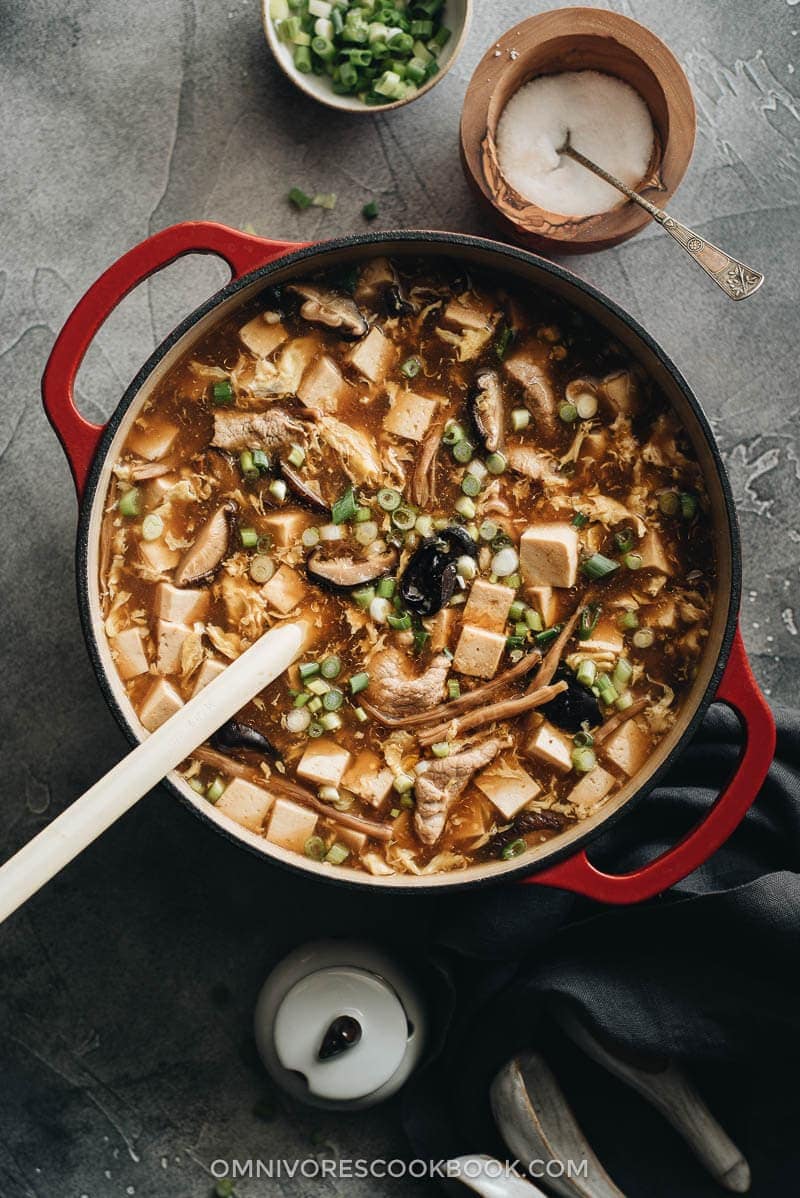
Hot and sour soup is such a popular dish takeout dish, along with egg drop soup and wonton soup. It’s one of those things that we almost always order when eating in a restaurant. The soup is loaded with so many goodies that I totally wouldn’t mind serving it as a main dish for a light dinner.
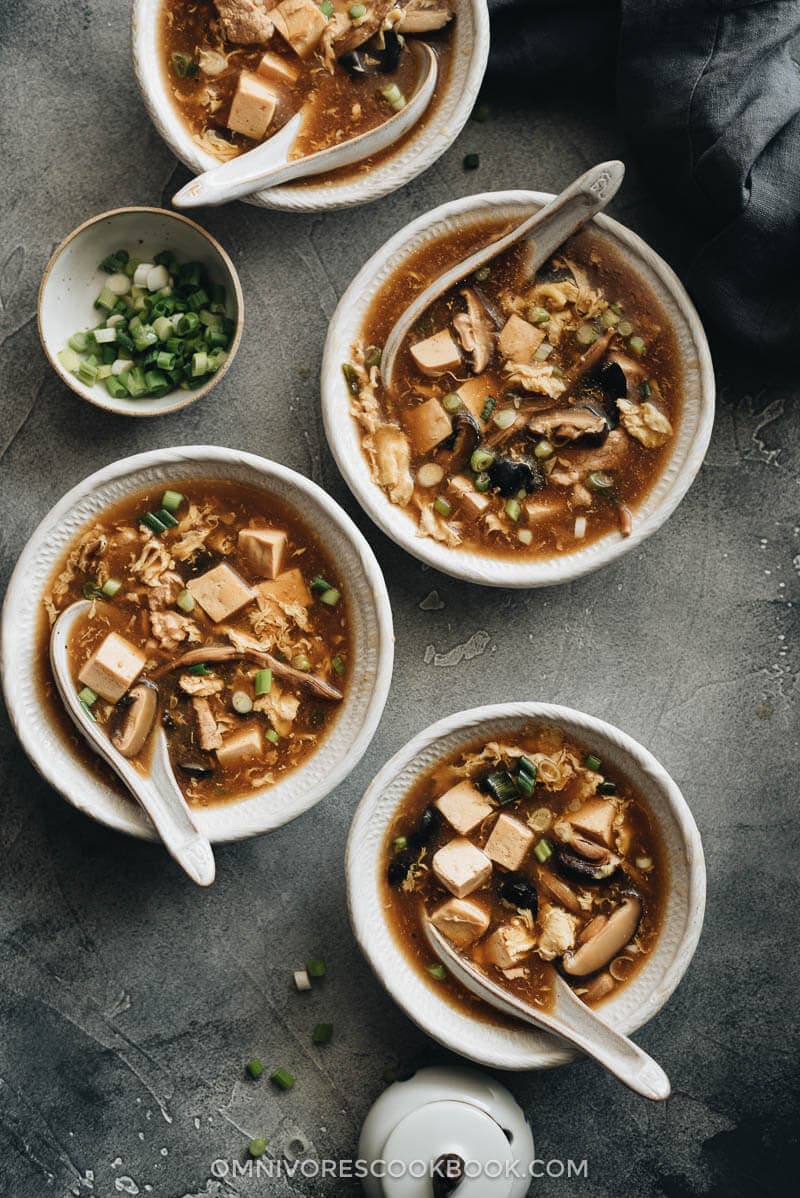
The soup base
Did you know that hot and sour soup is actually super easy to make?
Yes, the recipe below might look a bit long, because I wanted to create a proper restaurant-style hot and sour soup for you. But in fact, the soup base requires only a few ingredients:
- Chinkiang vinegar
- White pepper powder
- Water mixed with cornstarch (to thicken the soup)
That’s it!
The sourness of the soup comes from the Chinkiang vinegar. And the spiciness comes from the white pepper powder. No peppers or chili oil required!
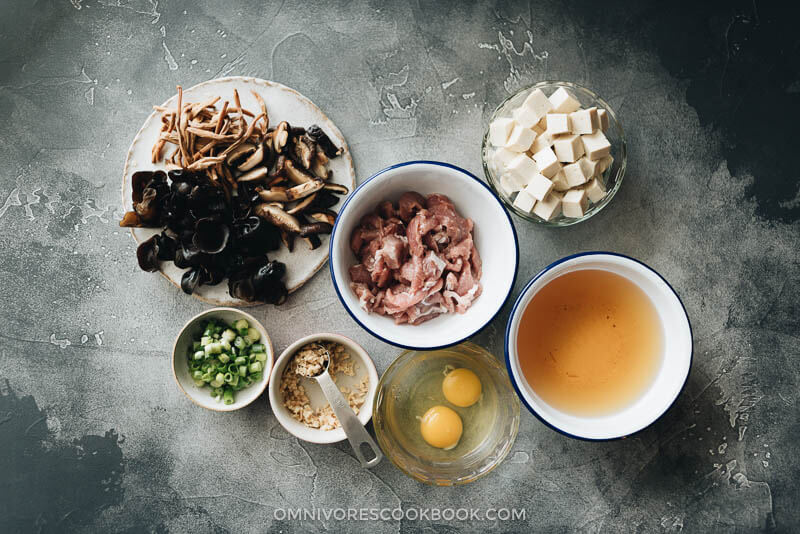
A word about the dried ingredients
My recipe uses some dried ingredients that might require a trip to an Asian market or a purchase on Amazon. But if you don’t want to make the extra effort, you can totally skip these ingredients. I will explain why.
I previously discussed how to use Chinese dried veggies to create a superior flavor in another recipe – Buddha’s Delight, a Jai (Buddhist vegetarian) dish. The logic is the same here. The foundation of the broth consists of dried lily flowers and dried shiitake mushrooms. They both have a very concentrated smoky, earthy, and woody aroma. Once you rehydrate them, the rehydrating water will turn a dark brown color as it becomes infused with the great flavor. Do not throw this water away. It is the best vegan broth and you should use it to make the soup base.
The other dry ingredient is wood ear mushrooms. It is a mildly flavored fungus that adds a crunchy texture to the dish.
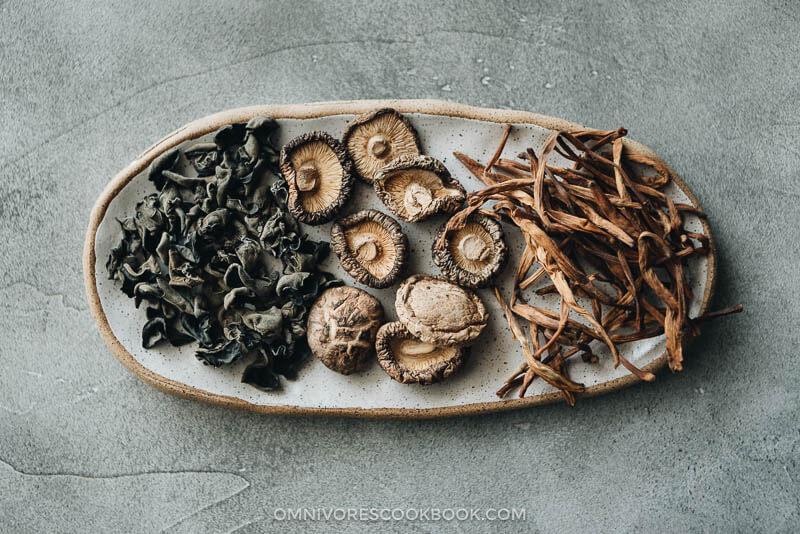
Chinese families always have these ingredients on hand because they allow a cheaper and healthier way to create a flavorful broth. If you use these ingredients, your soup will turn out more like the Chinese restaurant version.
However, if you do not have these ingredients, simply skip them and use chicken stock or vegetable stock instead of water to make your soup.
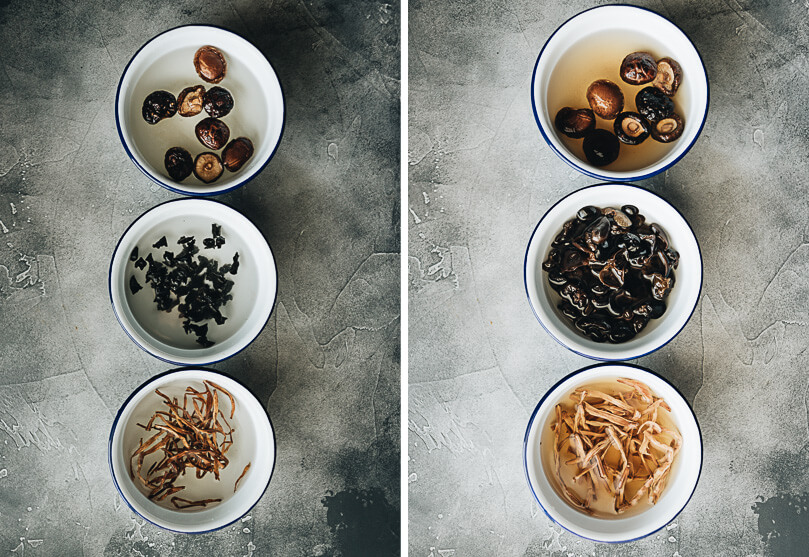
Cooking notes
1. How to convert this recipe to vegetarian
Simply skip the “marinate” part of the recipe, including the pork and the few ingredients for the marinade. Many Chinese recipes use a small amount of meat to add volume and texture to the dish. Skipping the meat won’t affect the flavor of the soup.
2. Other vegetables and proteins to use in this recipe
There are so many more ingredients that work well in this dish.
For example, some of my favorite vegetables include – tomatoes, napa cabbage, bamboo shoots, mushrooms, and bok choy.
You can also use a different type of protein to replace the pork. For example, chicken or shrimp would work great. You can even throw in a few slices of cooked sausage or ham to make the cooking faster.
3. Workflow
Add vinegar and white pepper at the end of cooking – this is very important. Otherwise the pureness of the vinegar will disappear as the vinegar evaporates and the white pepper will release a bitter taste if heated for too long.
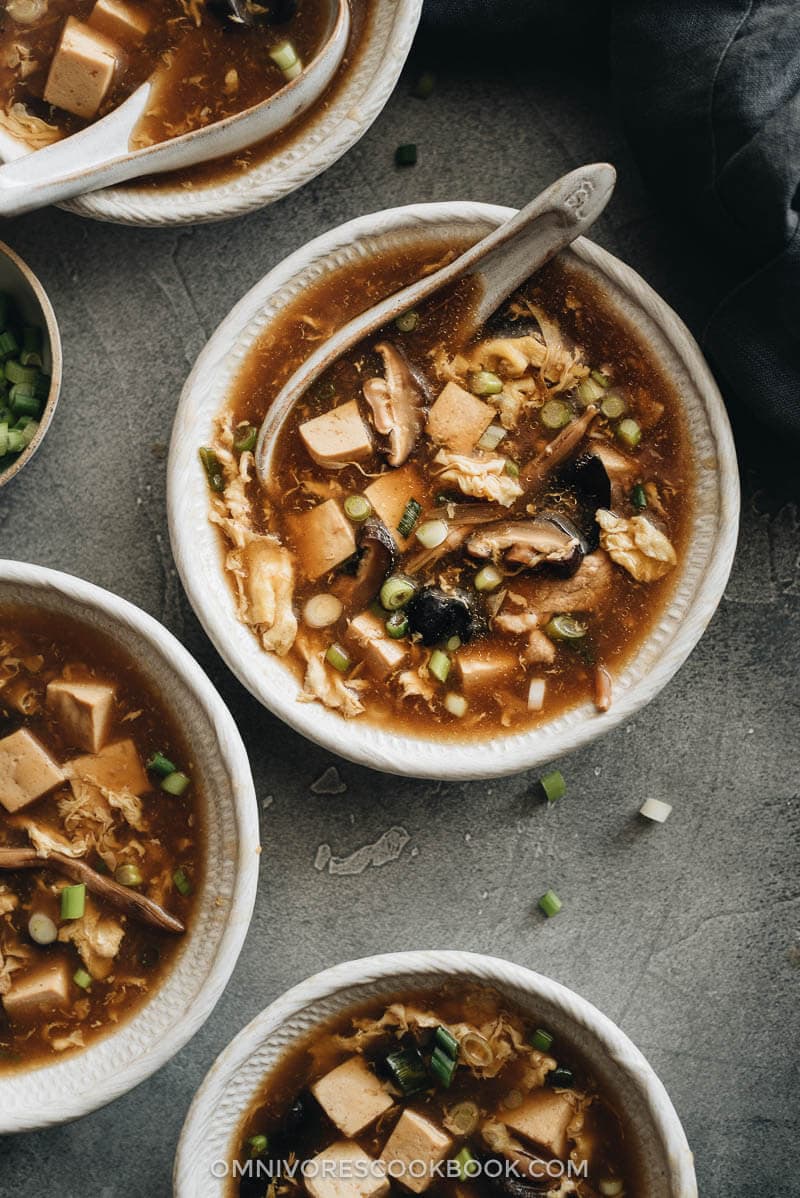
More Chinese takeout recipes
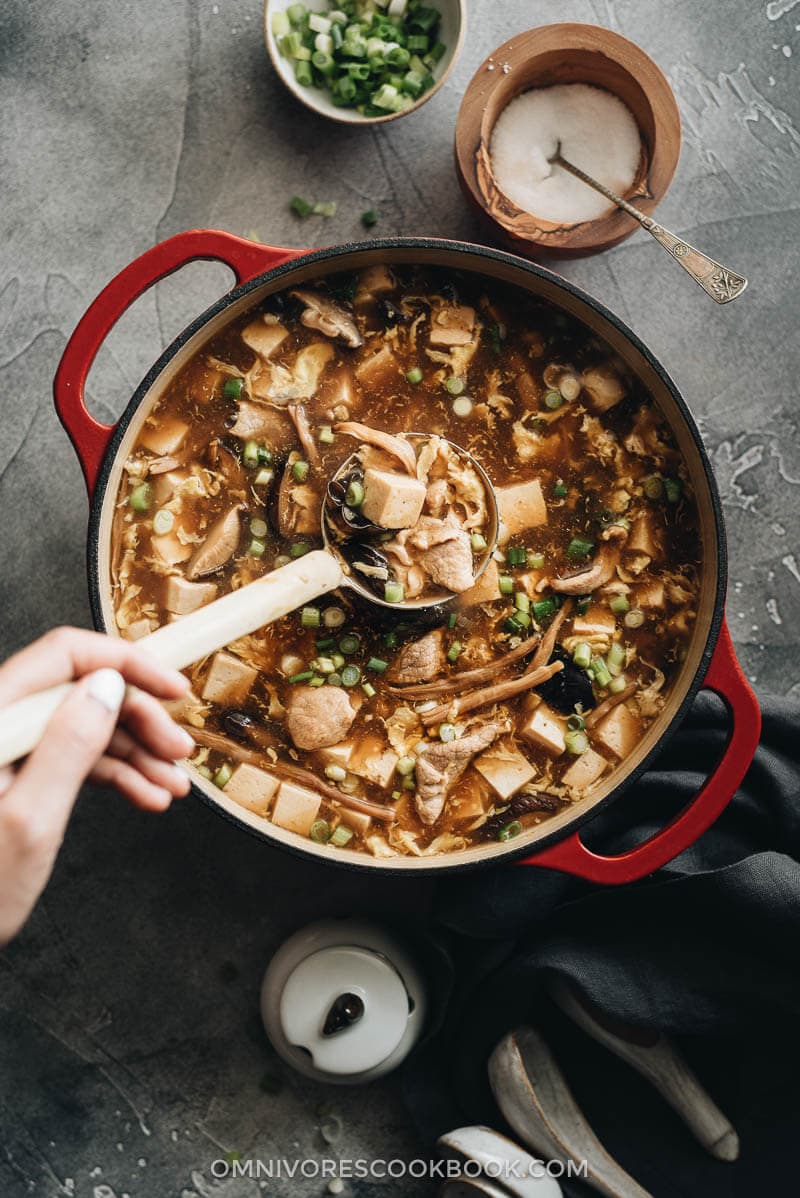
If you give this recipe a try, let us know! Leave a comment, rate it (once you’ve tried it), and take a picture and tag it @omnivorescookbook on Instagram! I’d love to see what you come up with.
Chinese Cooking Made Easy
Are you new to this website? This free email series is a great place to start. I’ll walk you through a few of my most popular recipes and show you how and why they work. You’ll quickly start to cook better Chinese food in your own kitchen.
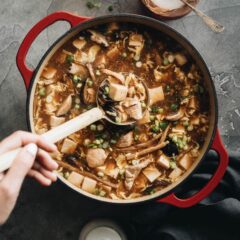
Hot and Sour Soup (酸辣汤)
Ingredients
(Optional) Rehydrate (*Footnote 1)
- 1/3 cup dried shiitake mushrooms
- 1/4 cup dried woodear mushrooms
- 1/4 cup dried lily flowers
Optional Marinate (*Footnote 2)
- 1/2 lb pork loin (or chicken breast) , cut into thin strips
- 1/2 tablespoon Shaoxing wine (or dry sherry)
- 1/4 teaspoon salt
- 1/2 tablespoon cornstarch
Soup
- 2 teaspoons minced ginger
- 2 green onions , chopped
- 2 tablespoons Chinkiang vinegar
- 1 teaspoon white pepper powder (or 1/2 teaspoon white pepper powder for a less spicy dish)
- 6 cups water (or chicken stock) (*Footnote 3)
- 1/2 block firm tofu (8 oz / 227 g) , cubed
- 1 tablespoon light soy sauce (or soy sauce)
- 3 tablespoons cornstarch
- 1 teaspoon salt or to taste
- 2 eggs , beaten
- 1 teaspoon sesame oil
Instructions
- Gently rinse dried shiitake mushrooms, dried wood ear mushrooms, and lily flowers with tap water. Soak each of them with 1.5 to 2 cups warm water in three big bowls. Rehydrate for 30 minutes to 1 hour, until tender. Slice mushrooms into strips. Snip off the tough ends of lily flowers and discard. Remove tough ends of wood ear mushrooms, then chop into bite-sized pieces. Reserve the marinating water from lily flower and shiitake mushrooms, 2 cups in total
- Combine pork, Shaoxing wine, salt and cornstarch in a bowl. Mix well by hand. Marinate for 10 – 15 minutes.
- Add Chinkiang vinegar and white pepper into a small bowl. Mix well until the white pepper is completely dissolved.
- Add water or chicken stock, ginger, and green onion into a pot and heat over medium-high heat. If you reserved the marinating liquid from step one, you can add it plus 4 cups water or chicken stock.
- Add rehydrated wood ear mushrooms, shiitake mushrooms, lily flowers, and tofu to the pot. Cook until bringing to a simmer. Add soy sauce and turn to medium-low heat.
- Mix the cornstarch with 1/4 cup of water in a bowl until cornstarch is fully dissolved. Slowly swirl the cornstarch slurry into the soup. Stir to thicken the soup.
- Add the pork from step one into the soup, stirring several times to prevent the pork strips from sticking together. Add the salt. Slowly swirl in the beaten egg and stir well. The egg should be scattered and not clotted.
- Remove the pot from stove. Add the vinegar and pepper mixture and stir to mix well.
- Garnish with cilantro and drizzle with sesame oil. Give it a final stir. Taste the soup and add more salt if needed.
- Serve hot.
Video
Notes
- If you do not have these dry ingredients, you can use half a pound of fresh mushrooms instead. Then use chicken stock instead of water to make the soup.
- Skip the meat if you want to create a vegetarian dish.
- Use chicken stock or vegetable stock instead of water if you are not using the dry ingredients (shiitake mushrooms, lily flowers, and wood ear mushrooms) in this recipe.
Nutrition
Have a question or feedback? Add a Comment
Did you make this? I want to see! Tag @OmnivoresCookbook on Instagram, and rate the recipe below.
The recipe was originally published on April 9, 2014 and updated on June 5, 2018.


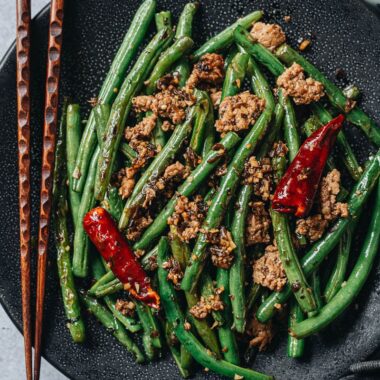
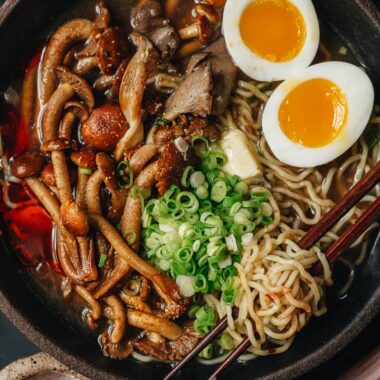
Gretchen
Finally made this with all the correct and authentic ingredients. It turned out SO delicious. Thanks so much so the great recipe resource.
Erin
I’ve made this several times without using the dried ingredients. It was always very good. However, this time I used the dried ingredients and their soaking water. WOW! Even more delicious and tastes just like what you get in a restaurant. Thanks for such an amazing recipe.
david l wilson
we love hot and sour soup. your recipe is easy to follow and watching the video was the best part of the presentation.
Kara
My family just LOVES this recipe. I usually just use fresh mushrooms and the chicken stock method. Always comes out amazing! It really isn’t confusing – just if you don’t use the mushroom broth from rehydrating mushrooms, use stock – 6 cups.
ZBear
Maggie, Your recipe is great as written, and provides an outstanding starting point to make “my” hot & sour soup recipe from!
I’ve made your recipe a number of times, and I substitute fresh baby Bella mushrooms for the dried ones, I always use chicken stock (3/4) & water (1/4). I’ve always used seasoned rice vinegar (never had the
Chinkiang Vinegar), and I’ve adjusted the seasonings and ingredient volumes to my taste…. so it’s still a “living recipe”.
My family of 4 DESTROYS the 16 Serving version inside of 3 days, or I try to stash some away in the freezer.
The funny thing is, my Hot & Sour Soup journey started up trying to match the recipe of Fu Hing’s, a restaurant in the Sacramento Valley town of Willows. Theirs is truly wonderful, I always attributed their flavor to the fresh homemade stock.
Thanks again for your outstanding take on this restaurant staple.
Maggie Zhu
Thanks so much for leaving a positive review and sharing your experience with this recipe! I’m glad to hear that the seasoned rice vinegar worked out, and your family enjoys this dish 🙂 This is one of my favorite thing to cook as well, especially in winter.
AliceK
I always use hot and sour soup as my gauge whenever we try a new Chinese restaurant. I would be very happy to receive this soup in a restaurant! We used already cooked leftover pork, and added bean sprouts, which added a nice crunch. I didn’t add the golden needles but had everything else. Really good, and very easy! (I added more vinegar, but that’s just me).
Chris
I love this recipe and I have done it several times. Wondering if I could substitute the tofu for Tempeh?
Maggie Zhu
I think you totally can. You will have a different texture (tofu is commonly used for the soft texture) but I don’t see it being an issue if you like tempeh.
Erica Smith
This recipe isn’t a walk in the park if you truly want to follow it to the letter in terms of using authentic ingredients, but with a trip to a local Asian market and one or two items ordered online, it all came together. I adjust some ingredient quantities to my taste, but the authentic flavor of this soup is perfect. I love good restaurant hot and sour soup but I actually like this even more since it’s never gloppy and tastes so clean and fresh. I’ve made this recipe at least 4 or 5 times now over the past couple years, and it’s fantastic.
David
It’s great but a bit complicated. Could you give us a stripped down version with the quickest and simplest way to get the essence of hot and sour?
Maggie Zhu
The key to make the hot and sour taste is the Chinkiang vinegar plus white pepper. The soup base is always good with ginger, and soy sauce and sesame oil to add flavor.
The rest of the soup ingredients can be very flexible if you have these seasonings.
The dried ingredients add texture and flavor to the broth. But you can skip some or all if you’re using chicken broth already as the base.
The tofu, eggs and meat add tender texture, and I highly recommend keeping at least one of them if not all (eggs are essential in my opinion).
And you can always add other veggies you have, such as napa cabbage, bok choy etc.
David
Great! Thanks.
Gee Gee
It should be obvious from the content of my review, but I forgot to rate this recipe the 5 stars it deserves! Sorry!!
GeeGee
I did love this recipe even though I had to make many changes based on what I had on hand. I really wanted hot and sour soup and decided I’d make it work starting with what looked like a great recipe. I didn’t have either of the mushrooms or the lily flowers – I only had button mushrooms. I hadn’t used my Chinese vinegar in so long, I decided it wasn’t any good, so I had to use rice vinegar. I didn’t use any meat, but I added bean sprouts and slices of baby corn. I didn’t know what to expect from the heat of chopped dried red peppers, so I cut back on those. Despite all that, it came out great! It was actually the best hot and sour soup I have made and I’ve made it several times using other recipes. I added some chile oil/paste to the leftovers because I wanted more heat and it was perfect! Goes to show what a great recipe can do, even with someone making it who didn’t have half of the correct ingredients!! LOL THANKS!
Cherry
So yummy esp on cold days…I didn’t have the optional ingredients, but I threw some lily bulb in as a substitute and it was still good. I made the vegetarian option and it still tasted great. Nice and quick, I was surprised at how quickly it was done. Will definitely make again thank you!
Niki
I’d like to make this, but I’m confused — it doesn’t make sense to add raw marinated pork to the recipe in step 7 (“Add the pork from step one 1”) and then remove the pot from heat in Step 8. And the pork was marinated in Step 2. When/how should the pork be cooked? Thank you!
Maggie Zhu
The pork is added towards the very end of the cooking, because they are very thin and can be cooked fast, like 2 minutes or so.
Once you add the pork (step 7), you will be adding the eggs, let the cook for 1 or 2 minutes, so the eggs properly set. Once you remove the pot from the stove, the soup will be still very hot and keep cooking the pork using residual heat.
That being said, if you are not sure (especially if you cut the pork into larger pieces), you can add the pork, let it cook for 1 to 2 minutes, then add the eggs. This way you can make sure they cook through completely.
Once you marinate the pork, the cornstarch will keep the meat tender as long as you don’t cook them for too long.
Gale
哈喽 Maggie,
Thanks for this recipe! I’m currently trying to do it right now but I encountered a question. I’m not comfortable at all in the use of imperial units (fellow European here), so my question is: how many dried mushrooms do you use? Is it about like in your pictures? I put about the same as the pictures above but I wanted to make it sure it was right for later
Thanks again for this recipe!
Maggie Zhu
It’s so hard to measure wood ear mushrooms because they come in different sizes and rehydrate in different rate. They are also light weight so it’s hard to measure on a scale.
I believe I used a scant 1/4 (60 ml) dried mushrooms, which gives you about 1 cup of loosely packed mushroom once dehydrated. The picture that shows the wood ear mushrooms in water is the amount I used in this recipe.
Janis
Not sure how your soup turned out so dark! Mine looked milky, not dark and rich. I added far more soy sauce than the recipe called for.
Maggie Zhu
Hi Janis, if you only use soy sauce, the soup won’t turn out very dark. The color is from dark soy sauce. Also depending on the brand of the dark soy sauce, the color might vary slightly (not by a huge difference).